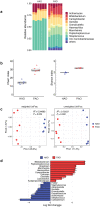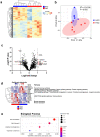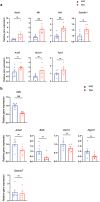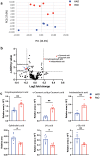Dysbiotic human oral microbiota alters systemic metabolism via modulation of gut microbiota in germ-free mice
- PMID: 35966937
- PMCID: PMC9373767
- DOI: 10.1080/20002297.2022.2110194
Dysbiotic human oral microbiota alters systemic metabolism via modulation of gut microbiota in germ-free mice
Abstract
Background: The effect of oral microbiota on the intestinal microbiota has garnered growing attention as a mechanism linking periodontal diseases to systemic diseases. However, the salivary microbiota is diverse and comprises numerous bacteria with a largely similar composition in healthy individuals and periodontitis patients.
Aim: We explored how health-associated and periodontitis-associated salivary microbiota differently colonized the intestine and their subsequent systemic effects.
Methods: The salivary microbiota was collected from a healthy individual and a periodontitis patient and gavaged into C57BL/6NJcl[GF] mice. Gut microbial communities, hepatic gene expression profiles, and serum metabolites were analyzed.
Results: The gut microbial composition was significantly different between periodontitis-associated microbiota-administered (PAO) and health-associated oral microbiota-administered (HAO) mice. The hepatic gene expression profile demonstrated a distinct pattern between the two groups, with higher expression of lipid and glucose metabolism-related genes. Disease-associated metabolites such as 2-hydroxyisobutyric acid and hydroxybenzoic acid were elevated in PAO mice. These metabolites were significantly correlated with characteristic gut microbial taxa in PAO mice. Conversely, health-associated oral microbiota were associated with higher levels of beneficial serum metabolites in HAO mice.
Conclusion: The multi-omics approach used in this study revealed that periodontitis-associated oral microbiota is associated with the induction of disease phenotype when they colonized the gut of germ-free mice.
Keywords: Oral; gut; liver; metabolome; microbiome; transcriptome.
© 2022 The Author(s). Published by Informa UK Limited, trading as Taylor & Francis Group.
Conflict of interest statement
No potential conflict of interest was reported by the author(s).
Figures






Similar articles
-
Oral Administration of Porphyromonas gingivalis Alters the Gut Microbiome and Serum Metabolome.mSphere. 2018 Oct 17;3(5):e00460-18. doi: 10.1128/mSphere.00460-18. mSphere. 2018. PMID: 30333180 Free PMC article.
-
Periodontitis-related salivary microbiota aggravates Alzheimer's disease via gut-brain axis crosstalk.Gut Microbes. 2022 Jan-Dec;14(1):2126272. doi: 10.1080/19490976.2022.2126272. Gut Microbes. 2022. PMID: 36175166 Free PMC article.
-
Patients with periodontitis exhibit persistent dysbiosis of the gut microbiota and distinct serum metabolome.J Oral Microbiol. 2025 May 8;17(1):2499284. doi: 10.1080/20002297.2025.2499284. eCollection 2025. J Oral Microbiol. 2025. PMID: 40351551 Free PMC article.
-
Oral-Gut-Brain Axis in Experimental Models of Periodontitis: Associating Gut Dysbiosis With Neurodegenerative Diseases.Front Aging. 2021 Dec 10;2:781582. doi: 10.3389/fragi.2021.781582. eCollection 2021. Front Aging. 2021. PMID: 35822001 Free PMC article. Review.
-
Intestinal MicrobiOMICS to define health and disease in human and mice.Curr Pharm Biotechnol. 2012 Apr;13(5):746-58. doi: 10.2174/138920112799857567. Curr Pharm Biotechnol. 2012. PMID: 22122483 Review.
Cited by
-
The oral microbiota: new insight into intracranial aneurysms.Ann Med. 2025 Dec;57(1):2451191. doi: 10.1080/07853890.2025.2451191. Epub 2025 Jan 13. Ann Med. 2025. PMID: 39803910 Free PMC article. Review.
-
Oral microbiota and respiratory diseases: advances and perspectives.Clin Microbiol Rev. 2025 Jun 12;38(2):e0015024. doi: 10.1128/cmr.00150-24. Epub 2025 Apr 2. Clin Microbiol Rev. 2025. PMID: 40172191 Review.
-
Oral microbiome, periodontal disease and systemic bone-related diseases in the era of homeostatic medicine.J Adv Res. 2025 Jul;73:443-458. doi: 10.1016/j.jare.2024.08.019. Epub 2024 Aug 17. J Adv Res. 2025. PMID: 39159722 Free PMC article. Review.
-
The oral microbiome in autoimmune diseases: friend or foe?J Transl Med. 2023 Mar 22;21(1):211. doi: 10.1186/s12967-023-03995-x. J Transl Med. 2023. PMID: 36949458 Free PMC article. Review.
-
Oral-gut axis as a novel biological mechanism linking periodontal disease and systemic diseases: A review.Jpn Dent Sci Rev. 2023 Dec;59:273-280. doi: 10.1016/j.jdsr.2023.08.003. Epub 2023 Aug 28. Jpn Dent Sci Rev. 2023. PMID: 37674899 Free PMC article. Review.
References
-
- Qin N, Yang F, Li A, et al. Alterations of the human gut microbiome in liver cirrhosis. Nature. 2014;513(7516):59–14. Epub 2014/08/01. PubMed PMID: 25079328 - PubMed
-
- Read E, Curtis MA, Neves JF.. The role of oral bacteria in inflammatory bowel disease.Nat Rev Gastroenterol Hepatol.2021;18(10):731–742;Epub 2021/08/18. PubMed PMID: 34400822; - PubMed
-
- Yachida S, Mizutani S, Shiroma H, et al. Metagenomic and metabolomic analyses reveal distinct stage-specific phenotypes of the gut microbiota in colorectal cancer. Nat Med. 2019;25(6):968–976. Epub 2019/06/07. PubMed PMID: 31171880 - PubMed
-
- Kageyama S, Takeshita T, Asakawa M, et al. Relative abundance of total subgingival plaque-specific bacteria in salivary microbiota reflects the overall periodontal condition in patients with periodontitis. PLoS One. 2017;12(4):e0174782. Epub 2017/04/04. PubMed PMID: 28369125; PubMed Central PMCID: PMCPMC5378373 - PMC - PubMed
LinkOut - more resources
Full Text Sources
Molecular Biology Databases
